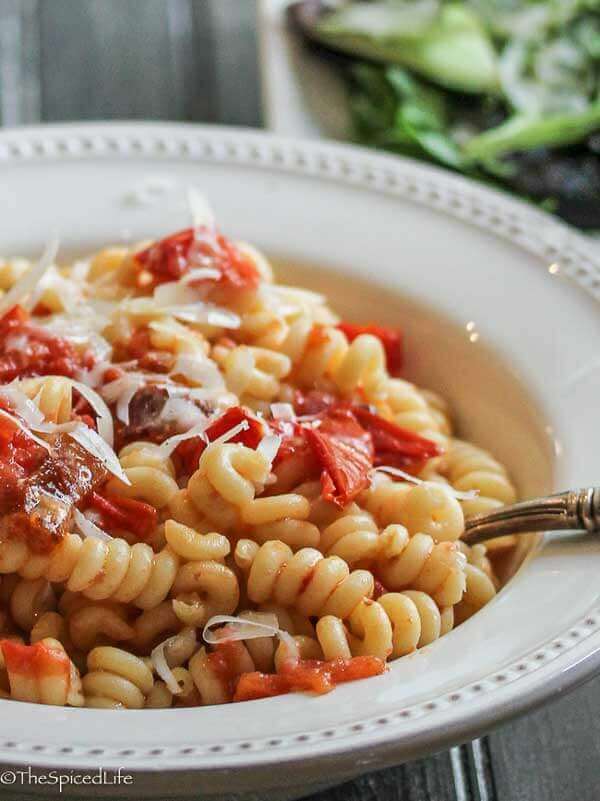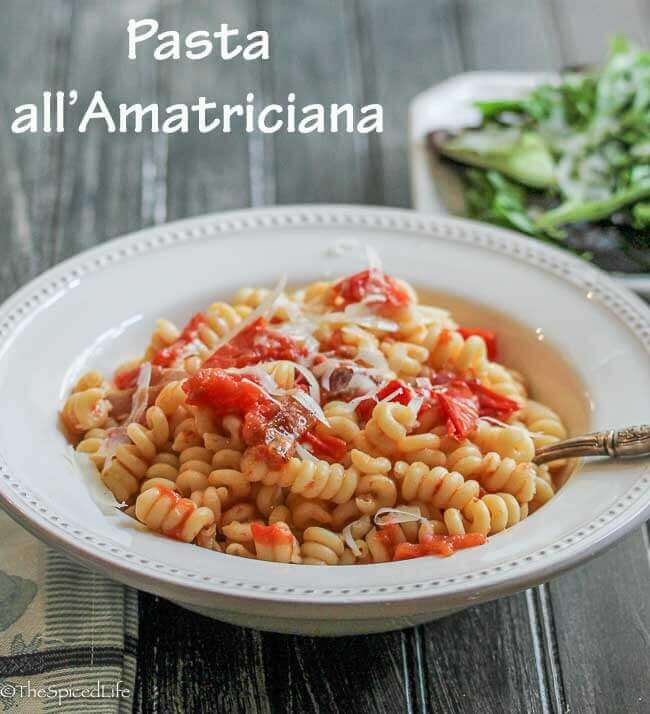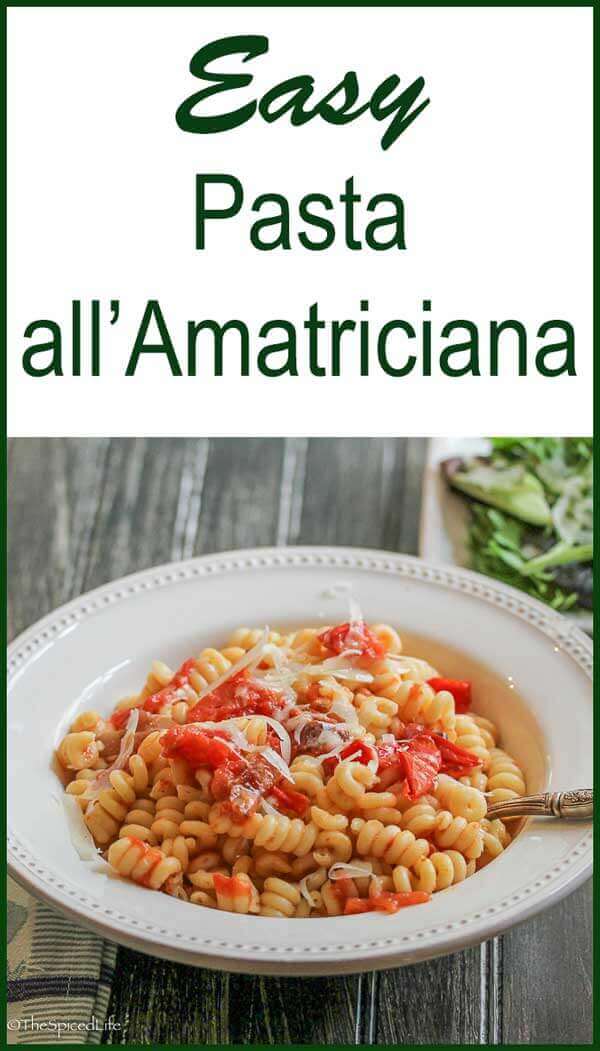Pasta all’Amatriciana is a simple, fast and delicious Italian dish that shows off tomatoes when they are at their best, freshly picked and vine ripened. Affiliate links have been used to link to items I am discussing.

Between broken air conditioning, sinus infections and school starting, I don’t think I have let you guys know how Skadi is doing. And come on, everyone wants to know about cute puppies. That cannot just be me! Our freaky smart evil overlord (as Sammy calls her) was recently at the vet, so I could work on sit and stay in a distracting environment while picking up Skamp’s new tick collar, so I had her weighed. If you have lost track, she is 6 and a half months old. She is 65 pounds, which I consider awesome since she is well on her way to being a tall, strong, big German Shepherd, which is what I really prefer. She is still the enemy of all floor mats, loves being with her people and has been the easiest dog to train I have ever had–floor mat issue notwithstanding.

OK on to Pasta all’Amatriciana…

Pasta all’Amatriciana is one of those deceptively simple Italian recipes that one undertakes with trepidation–because the Italian Cuisine Police lurk among us. Carbonara is an example of what I am talking about. Have you ever listened to a native Italian talk about the various recipes that are called carbonara? The peas are an offense my friends. As is the bacon. Enjoy them all you want, I won’t tell, but just know there are some seriously horrified people out there. And in fairness there are some Thai and Indian ingredient issues that can drive me bonkers. So since I live in a glass house I guess I better not toss too many stones.

However, I believe that as a person who truly does want to learn to make things as traditionally as possible–so when I deviate I know I am deviating–I have found the perfect cookbook for the Italian pasta aficionados out there: Sauces & Shapes: Pasta the Italian Way, by Oretta Zanini de Vita and Maureen B. Vant. First of all, it is encyclopedic in the best way possible (400 pages!). If there is a pasta you enjoyed somewhere in Italy I bet you find it here. Second, it is authentic also in the best way possible, meaning it discusses the traditional ingredients, but is not overly rigid, does not preach and it even discusses the fact that for example, as in Amatriciana, the dish’s name comes from Amatrice and thus some people insist you must use a pecorino from Amatrice, but it could be from Abruzzo or Sicily, and in Rome, the norm is still Pecorino Romano. Which is by far the most easily available pecorino (Italian sheep’s milk cheese) here. Phew! Likewise, people can get worked up about the pasta shape (which is why you might be most familiar with Bucatini all’Amatriciana), but as the authors discuss in their introduction, if Italians were historically that fussy about pasta shapes, so many delightful and unusual shapes would never have been invented. Whenever I am using a high quality imported pasta, I always choose the more unusual shapes, and I did here too (those are fusilli, or twisted spaghetti).

OK, now that I told you all the ways you can flout supposed tradition when making Pasta all’Amatriciana, here is where, in my opinion, you should not. The guanciale. I have sung its praises before and I will again here. Its peppery cured pork belly flavor has no true substitute. Pancetta and bacon are not at all the same. But there is good news: it is pretty shelf stable. So you can order it, for example, from Amazon (that’s an affiliate link):
Wondering what you will do with the rest of that porky deliciousness? Check out my other recipes with guanciale, and keep checking back. After all I have a package to slowly use up also!


Closely adapted from Oretta Zanini de Vita and Maureen B. Fant. I am sure many of you will be tempted to make this dish with pancetta or bacon--and if you make it that way and like it, more power to you (maybe don't tell any Italians you know!). But for me the guanciale is the key. It's very distinctive (black) peppery cured pork belly flavor is what elevates this dish from just being a basic summer pasta tossed with fresh tomatoes.
- 1 lb dried pasta of choice
- 2 1/2 oz guanciale, cut into thin strips
- 2-3 T extra virgin olive oil
- 1 small onion, chopped (any kind) (traditionally optional, but I will always opt for the onion)
- 1 lb local, recently picked tomatoes, coarsely chopped (traditionally you can also use canned Italian tomatoes, but to me this dish is made for tomato season)
- 1 pinch dried chile pepper flakes
- salt to taste (see instructions)
- 7 heaping T (70 g) finely grated pecorino (in Italy the source of the pecorino can become controversial but in America chances are best for finding Pecorino Romano)
- Additional more coarsely grated pecorino for garnish
-
Bring your salted water in a large pot to a boil and then turn the heat off. This way it will not take long to boil when you are ready for it.
-
I found it easiest to make this in a nonstick skillet, although obviously generations of Italian housewives made do just fine with steel. Place the oil and guanciale in a large, deep skillet over medium heat.
-
Let the guanciale heat gently and begin to render fat and brown. Right when it is becoming crisp, add the onion (if using) with a pinch of salt (if you are using canned tomato, check the ingredients--if they are salted, only add a tiny pinch).
-
Sauté the onion, stirring occasionally, until it is translucent. Add the tomatoes and chile pepper flakes. Taste a cooked onion--if it is not salty (the guanciale can vary in saltiness) and if you are using raw tomatoes add another pinch of salt. For canned, check the label to see if they have salt added.
-
Bring the pasta water back to a boil and add your pasta to cook. When it is done, be sure to reserve the cooking water.
-
Reduce the heat on your onions and tomatoes to low, to simmer gently for 20 minutes. The sauce should thicken a little and the fat should separate to the surface of the mixture.
-
When the pasta is cooked, drain it and place it in a bowl and toss it with the finely grated pecorino. When the sauce is ready, toss the pasta into it. If it seems to dry and needs to loosen, add a little pasta water. This is not a dish that should need a lot of the pasta water, so add it by the 1/4-cup.
-
Serve the pasta immediately topped with a few coarse grates of pecorino.
Looking for a collage to pin?


Looks delicious.
Love, mom